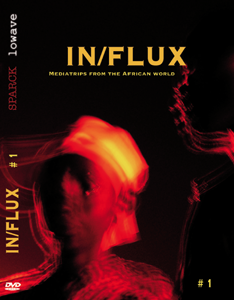
Title: In/Flux
Published with: Lowave (Paris, France)
Official Release: October 2010
SPARCK has developed a partnership with Lowave, an award-winning Paris-based film production company known for innovative content and practice. Lowave makes and distributes high-quality experimental arts videos and documentary films, priced so that they are available to large numbers of people outside the types of rarefied venues where works of this genre are typically shown. Lowave productions are showcased in cutting-edge, socially and politically committed festivals across the world and have won many accolades.
In 2007, Lowave initiated a DVD collection that explores experimental arts video from beyond Euro-North-America. This collection has given rise to several award-winning DVDs. Each DVD is a compilation of work by both well-known and emergent filmmakers. All have French and English subtitles and are accompanied by an introductory text and bonus features, making the Lowave DVDs highly accessible to diverse audiences and contexts across much of the Anglophone, Francophone and Arabophone worlds.
In October 2010, Lowave and SPARCK, with critic Cédric Vincent, launched the first of three DVDs dedicated to Africa and her Diasporas. The title of this series is IN/FLUX. IN/FLUX explores radical takes from the African world on emergent urban cultures and imaginaries. Hailing from many places and viewpoints, the films compiled in IN/FLUX Volume One speak in distinctly counter-hegemonic voices to the nature, complexities and alternative possibilities of movement in and between cities of the global present-future. Volume Two considers urban his/herstories and memories. Volume III offers multiple takes on urban body politics.
Volume I: Dineo Bopape, Stacy Hardy, Khaled Hafez, Ismail Farouk, Mowoso, Neil Beloufa, Goddy Leye, Nástio Mosquito, Ahmed El Shaer, Julia Raynham.
Volume II: Bofa da Cara, Theo Eshetu, Zineb Sedira, Sammy Baloji, Aryan Kaganof, Fayçal Baghriche, Nina Barnett, Berni Searle.
Volume III: Goddy Leye, Zen Marie, Heddy Maalem & Benoît Dervaux, Ala Eddine Slim, Ezra Wube, Kgafela Oa Magogodi, Naadira Patel, Steven Cohen.
For reviews in the journals/newspapers Africultures, Transversales and Le Monde Diplomatique, click here, here and here.
The official launch of IN/FLUX – Mediatrips from the African World took place on 15 June 2011 in Paris, at the Cinéma Le Nouveau Latina.
Dominique Malaquais and Silke Schmickl presented the DVD and talked about the collaboration between SPARCK and award-winning film production company Lowave, which has given rise to the first of three DVD compilations of experimental art and video from across the African continent.
The screening was followed buy cocktails at the Salon Rouge as well as a special performance by LOUBAKI and Cameroonian-French artist collective Doktorosé.
Watch the IN/FLUX Trailer
Filmakers and films featured
Dineo Bopape (South Africa) – Under All Means Necessary – 2006 | 5’29
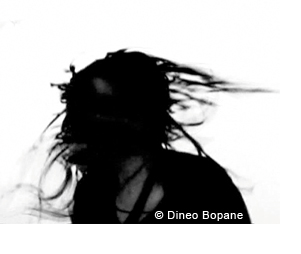
A woman shakes her head slowly, looking to and away from the viewer/camera. What appears to be passive refusal slowly gathers speed and proceeds into a full-tilt frenzy of head shaking, a maddened refusal. As the film proceeds, the image, in constant and increasingly frantic movement, breaks down into a disco of dots, pixels, abstracted lines, shapes and colors. The score, an inter-woven, sped-up, doubled, slowed down, sniped mix of sounds – drumbeats, footsteps, audience cheers and songs layered in an orchestral mess/harmony – amplifies the violent shake-up going on on the screen.
Mowoso (DRC) – Postcolonial Dilemna – 2009 | 3’37

A woman appears. She is in a trance. An axe is buried in her skull. As we struggle to establish what is going on, the scene shifts and she appears behind a desk, in a peculiar exchange with a man who is either paying her a bribe or dispensing some manner of mystical treatment. A train rushes across the frame in fits and starts. This is the postcolony: dystopic interzone, part dream, part nightmare and impossible urban snarl.
Goddy Leye (Cameroon) – The Voice of the Moon – 2005 | 3′
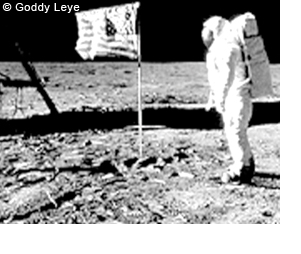
A man alights on the moon. Neil Armstrong is there. In a steady stream of dance steps, to the sound of Cameroonian music, the man – the artist himself – moves toward the American astronaut. Slowly, Leye merges with Armstrong, becoming one with his body in a brief burst of Afrofuturist invasion. This short film is part of a larger five-channel video installation. Using a paired down aesthetic, it examines with humor and irony the history of colonial and neocolonial expansion and the imagery of empire. The film and the larger installation also query how television news footage spreads hegemonic narratives and shapes the collective unconscious of political subjects.
Stacy Hardy, Jaco Bouwer (South Africa) – I Love You Jet Li – 2005 | 11’20

Beijing, China. International Wushu master and cult Kung Fu film legend Jet Li tours the city to promote his latest blockbuster action film. 12 000 km away, at an airport in Africa, a young woman waits to fly out to meet him. What follows is a peculiar tale: part love letter, part post-traumatic electronic travel diary. Written by Stacy Hardy and directed by Jaco Bouwer, with an original soundtrack by acclaimed experimental electronic composer Felix Laband, the film speaks of intense loneliness, desire, anxiety and incomprehension in the face of movement – across space, borders, class and gender divides – at once always incipient and forestalled.
Ismaïl Farouk (South Africa) – God’s Land – 2009 | 2’15
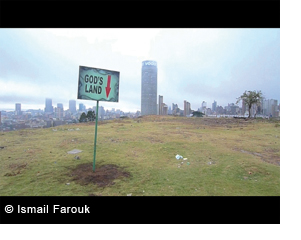
In Highlands Hill in Yeoville, a neighborhood of inner city Johannesburg, hundreds of worshippers gather daily to pray. This causes friction with the municipality, which has earmarked the area for housing re-development. The City Parks authority has designated the Hill as a “no prayer” zone and threatened mass arrests. By altering existing exclusionary signposts on the Hill and focusing his camera work on the footfalls of a man walking freely across it, the filmmaker, an urban gepgrapher, highlights social injustice issues that pit the spiritual needs of local communities against mainstream development.
Julia Raynham (South Africa) – Rulings of the Night – 2008 | 3’47

Two dancers move from the heights of Table Mountain, overlooking Cape Town, to the bowels of the city: a car park and then the aisles of a supermarket lit ghastly white. They are accompanied by a bird of prey and stalked by the ghostly presence of a mystic gorilla. Following in their wake, we question what the human race and the late capitalist system to which it is in thrall have done to the cities they call home.
Nâstio Mosquito (Angola) – The Real People – 2009| 5’44
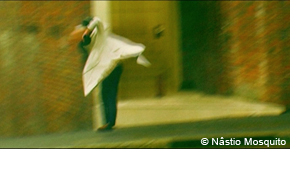
A woman walk/skips/dances through the streets of a city that is and is not European, to the sound of a rap that is and is not African. The voice in the rap tells it like it is: if you want to be someone, you have to beat someone. That’s how it is in the city: the un-named city, every city, the global city. Manning the camera and the mike, Nástio Mosquito offers a radical critique – part Fred Astaire number, part Rainbow Nation schtick – of the idealised postcolonial urban landscape, diverse, wide open, where everyone, so they say, can make it.
Neil Beloufa (Algeria/France) – Kempinski – 2007 | 14′
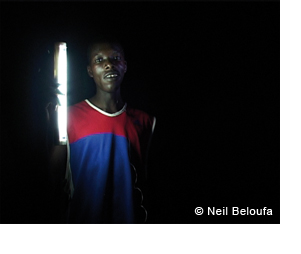
Welcome to Kempinski. The inhabitants of this mystical / mythical place – is it a city, a country, a planet? – are preparing to fire rockets into outer space. They will also be deploying satellites and visiting distant galaxies. So they explain to the camera, mostly by night, to the sound of buzzing electrical cables overhead. Filmed in the historic city of Mopti in Mali, this “documentary” about movement across space and time is unscripted. A single rule obtains and threads throughout: interviewees imagine the future and, in the act of speaking, bring it into the present.
Khaled Hafez (Egypt) – The a77a Project (On Presidents and Superheroes) – 2009 | 4′

This short, ironic film reflects on recent social changes in an African megacity: Cairo. Two figures drawn from a large-scale canvas by the artist are cast in motion via 3D animation and morph into the ancient god Anubis. The Lord of the Afterlife walks through the streets of present-day Cairo, past scenes of daily life, in what was once described as “one of the most beautiful downtowns in the world.” The film’s score is a mix of sounds drawn from cyberspace and archival voice recordings: re-worked open-source digital loops and samples of Egyptian president Nasser delivering his famous 1967 resignation speech.
Ahmed El Shaer (Egypt) – Under Examination – 2009 | 3′
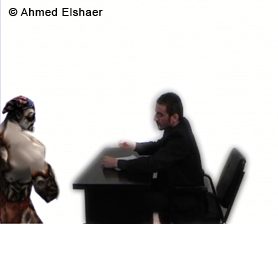
A citizen of Digitaland is seeking a visa to enter Planet Earth. A bureaucrat from the host planet, in charge of controlling movement at the border, is compiling information on him. In the background, disembodied voices speak of “criteria”, “indicators” and “standards”. The traveler has no readily recognizable features: he is no different from any other being created (as he was) with Machimana software. On his forehead is an American flag bandana. Why he is wearing it is unclear; possibly he means to convince the bureaucrat that he is a good candidate for immigration. Obtaining a visa these days is complicated, especially if you’re trying to negotiate passage from and alien-nation into the “real” world…
